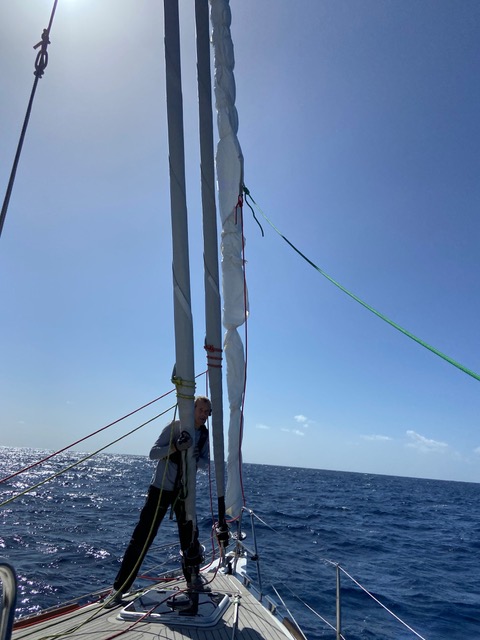Lanzarote to Grenada, day 9 (Blue Water Runner is back)

Stravaig'n the Blue
Mon 18 Jan 2021 22:45
End of day 9 position: 21:58.0 N 033:29.6 W (1729 NM north of Cabo Branco, Brazil) Position timestamp: Monday 18 Jan 2021 12:00 UTC-2 Distance travelled last 24 hours: 153 NM Reduction in distance to destination last 24 hours: 126 NM Distance travelled total: 1357 NM Average speed since departure: 6.2 knots Shortest distance to destination: 1735 NM ETA based on shortest distance and average speed so far: the wee hours of 30 January (20.7 days in total) Blue Water Runner is back. It has been a frustrating few days. The wind has been blowing directly towards Grenada but we have been unable to sail a straight line course there because our dead downwind sail, the BWR, has been languishing on the sofa, waiting for lighter winds so that we can check that all is well with our manual furling and other work on it following Thursday’s wrap. Instead, we have been sailing around 30 degrees off the wind under reefed mainsail and regular headsail; this has given us comfortable sailing and reasonable speed but only circa 85% (cosine 30 degrees) of the speed has been effective in reducing the distance to Grenada. We have however put the time to good use, repairing the melted furling line (see pic below) and thinking through how we’d go about checking the sail, anticipating problems that might arise and coming up with solutions to these. The most likely problem is an uncontrolled unfurling as we hoist the BWR; our manual furling has produced a rather loose and lumpy result that is likely to catch the wind during the hoist and is one of the reasons we required lighter winds for the test.  With no light winds forecast we reasoned that we could simulate light winds by motoring at speed in the same direction as the wind and the direction of travel required to hoist and unfurl the BWR. Motoring with the wind reduces the boat’s apparent wind, the wind impacting the boat. We overcame the unfurling problem further by borrowing a solution from my days racing Sunfast 36s round the cans in the Solent during Sunsail’s beginning and end of season regattas many many years ago. One of this blog’s readers, RBN, will remember it well. On the upwind leg of these races, while everyone else was on deck ensuring the boat was going as fast as possible while enjoying the racing tactics and the sea air, RBN was below, rolling up the spinnaker and tying it with knitting wool every few feet. When complete, we’d hoist the rolled up spinnaker while still beating to windward so that we could break it out the second we were round the top mark. The wool held the spinnaker in a roll for the hoist but broke as soon as the sheet and guy were pulled to open it. Other crews were using the same technique so it didn’t win us many races but it certainly helped ensure we never came last (although that could be selective memory at work). It came as a genuine surprise to me that we have no wool on the boat. However, Linda came up with the idea of using masking tape and, after checking the breaking strain of the three types we have on board, we settled on B&Q’s bog standard creamy brown tape. I had emailed the ever helpful Jeremy White at Elvstrom Sails in Hamble Point, suppliers of the BWR, with some technical queries on Sunday night and he had replied first thing Monday morning with the answers I had hoped for. This morning (Monday) the wind was blowing 18-20 knots and the swell was 1 - 2 metres, occasionally 3. Good enough. After breakfast we snaked the 16 metres of the BWR out of the saloon, up the companionway steps, round the spray hood, down the the side deck and on to the fore deck.  While I re-attached the furling gear and sheets and removed the strong whipping twine we tied around the sail on Friday, Linda did masking tape loops every half metre or so.  We then furled the headsail, turned the boat head to wind and dropped the main sail, turned back down wind, double checked that everything was ready for the hoist and upped the engine revs.  The first hoist had to be abandoned when I realised I’d tied the starboard sheet to the port clew, and vice versa. The second hoist went well, the sail’s rubber furling rod straightened out under tension and the masking tape held.  Now the unfurling. We put the sheets on the winches and pulled. Pop, pop, pop … the first half a dozen masking tape loops gave way then things stopped. We pulled harder. No joy. We checked that nothing was snagged and then started grinding with the winch handles and then suddenly pop, pop, pop …. the rest of the sail unfurled and a shower of masking tape strands took to the wind. (I’m sure they are biodegradable.) I later discovered the problem was one of the whipping twine loops had eluded me and required winch pressure to snap. A close inspection of the sail revealed no issues. Time for another late lunch. It is a good feeling to be sailing directly to our destination and at a cracking pace to boot. All is well. Allan |